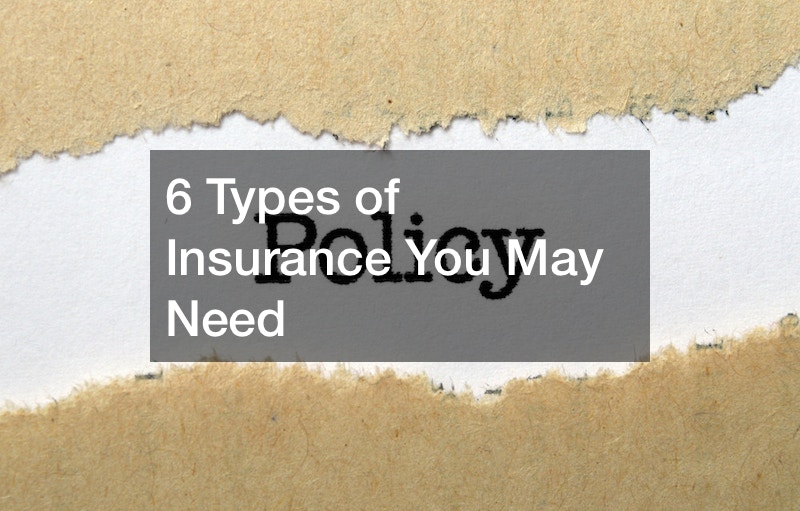
Adulthood brings the need for many types of insurance that your parents previously provided. Upon reaching the age of 18 years, you become responsible for your own insurance policies. For most individuals, that means they take over their auto insurance, no longer appearing on their parent’s policy. Those attending college may need a renters insurance policy to provide financial protection for the personal property they keep at school.
Most colleges offer group health plans, but young adults who don’t attend school after high school may remain on their parent’s health insurance until they reach the age of 21. So it goes, the number of insurance policies a person owns increases with age. Here’s a quick guide to what each of the types of insurance provides and when you need to buy it.
Insurance offers financial protection for your tangible assets, like a car or house, and intangible assets, like your health and life. It can’t prevent a peril or event from occurring, but it can make sure that you don’t have to pay out of your own pocket when something bad happens. You pay a small premium each month for the insurance to keep it in force. If a peril that your policy covers occurs, you file a claim and the insurance company processes it, typically sending an adjuster to determine the payout.
1. Auto
The first type of insurance a person typically buys – auto insurance – they purchase as soon as they earn their driver’s license. Each U.S. state passes auto insurance laws that require minimum coverage for every driver on the road. These state laws rarely require more than liability coverage consisting of bodily injury and death coverage and property damage coverage.
Full coverage auto insurance covers every aspect of bad things that can happen while operating a motorized vehicle. It adds collision coverage and comprehensive coverage to the state-mandated minimums. Some insurance companies also offer roadside assistance packages, so when an accident or auto breakdown occurs your towing safety ride gets paid for by insurance.
Auto insurance does things a little differently than other insurance types. The roadside assistance part pays for the service outright, so you don’t usually wait for a reimbursement. If you run out of gas, dialing the number for roadside assistance gets you a tow truck to your location that delivers a gallon of gas to get you on your way again. If you tip the driver, that’s up to you, but the insurance pays for you.
With the two liability components, the insurance company pays you nothing and you pay nothing, so long as the accident you caused did not injure so many individuals that it depletes your coverage or one individual so severely that it depletes it. The series of numbers like 25/50/25 or 50/100/75 refer to the policy maximums of an auto policy. The first number in the series, the 25 or 50, refers to the bodily injury and death coverage per person per accident, while the second number, the middle 50 or 100, refers to the total bodily injury and death coverage per accident. That means that if you purchased the 50/100/75 policy and police found you at fault for an accident that injured four individuals, the policy would pay each of the four people up to $25,000, typically writing checks to the hospital directly for their medical costs.
If only one individual got injured in the accident, the policy would pay up to $50,000 to the individual to cover their medical costs. Although the policy states it pays up to $50,000 per person per accident with the middle number, it conveys that it caps the policy at $100,000. If the medical costs of the injured exceed your policy maximums, you must pay the remainder of the person’s medical costs out-of-pocket.
The final number of the policy’s maximums, the 25 or the 75, refers to the property damage coverage. That number indicates the total amount payable to all parties for auto damage and damage to their property inside their vehicles in an accident you cause. Any damages over that amount that insurance does not pay for, you pay for out-of-pocket.
Minor accidents, such as fender-benders, insurance typically covers fully. For any serious auto accident, you should hire an auto accident attorney. Also called personal injury attorneys, these lawyers protect your interests with the insurance companies involved and the other parties involved in the accident.
Avoid purchasing only the minimum insurance. Always add at least collision coverage, so your insurance covers the damage to your own vehicle, too. Collision policies apply to all accidents involving any type of collision, whether single vehicle or with another vehicle. If a deer runs out in front of your vehicle, this insurance covers the damage by reimbursing you for the vehicle repairs or cutting a check for your mechanic’s pay that goes directly to them.
Comprehensive coverage pays for damages to your own vehicle caused by a peril named in the policy. Examples of perils typically covered include fire and theft. Without adding this coverage, your insurance won’t cover such events and you would need to pay out-of-pocket to repair or replace your vehicle.
Although the insurance industry refers to it as auto coverage, the state laws refer to all motorized vehicles or conveyances. That means the state laws require the same minimum level of coverage whether you own and/or operate an automobile, motorcycle, trike, or recreational vehicle (RV), also called a motorhome. The insurance industry provides specialized policies for each, vehicle type. Within the overall confines of auto insurance, you will also find motorcycle insurance and RV insurance.
2. Pet

At some point in their lives, most individuals adopt or rescue a pet. Caring for a pet, whether a dog, a cat, a bird, or something else, costs much more than just buying food for it each week. Pet insurance provides health insurance for the animal in your life.
Policies vary on what they cover, so consult with an insurance agent before purchasing a policy. Some pet insurance policies only cover emergency veterinary service, so you do not need to pay out-of-pocket when your pet needs emergency care due to an accident or sudden illness. Other policies also provide coverage for annual exams, prescriptions, and vaccinations.
Before you purchase pet insurance, check with your animal’s vet to find out which, if any, pet insurance policies they accept. This ensures you do not need to change vets to use the insurance policy. If you don’t already have a regular vet for your pet, check with a few local veterinarians to find out which policies they accept, so you will have a choice in where to take your pet.
3. Dental
The equally straightforward dental insurance lets you pick your dentist from those who accept its dental coverage. Dental policies pay for annual checkups, teeth cleaning, and some dental work, and may cover orthodontic straightening. Like pet insurance, policies vary vastly in coverage, so meet with an insurance agent in person or on Zoom to discuss what coverage you need and find the right policy.
Your dental goals determine which level of coverage you need. If you know that you want to get Invisalign, look for a policy that covers that straightening method. If both of your parents needed dental crown work in their later years, look for a policy that covers fillings, so you can retain your teeth.
Some dental policies cover dentures, but few cover the full cost of dental implants. Policies that do cover these expensive treatments that create a permanent tooth from a steel post and a screw-on tooth cost a hefty monthly premium. Consulting with an insurance agent before purchasing coverage ensures you obtain a dental policy that covers your most important goals.
4. Renters

As mentioned, some individuals purchase their first renters insurance to cover items in their dorm room. This insurance policy covers only the personal property of the renter. Some landlords require this type of insurance from their renters because the stipulations in their rental property loan require it. Others require it to reduce their own liability.
A type of home insurance, renters insurance provides contents-only coverage for the rental home and only the contents owned by the renter. It also provides liability coverage, so if the renter has a guest who falls getting out of the shower and sprains their ankle, the renter’s insurance covers the medical visit and crutches. The policy a person takes out to cover their apartment or rented house may or may not also cover their belongings during a stay in vacation houses for rent. Check with your insurance agent before purchasing a policy, so you choose one that provides the coverage you need.
5. Disability

Also, contact an insurance agent before purchasing disability insurance because the phrase refers to a variety of policy types and situations. The U.S. government provides a program called Social Security Disability Insurance, which refers to the division of Social Security that provides monthly payments to those who qualify for federal designation as partially disabled or totally disabled. Qualifying for this program requires an application to the federal program. It does not refer to an insurance policy that you purchase.
In certain cases, when the applicant does not substantiate the level of disability or the permanence of it, the SSDI might refuse a claim. The individual can hire a disability lawyer to appeal the SSDI’s initial decision. This process can take some time and in the meantime, the individual needs money to live off of. These funds may come from a workers’ compensation claim, savings, or other sources, such as personal disability insurance.
Personal disability insurance, also referred to as long-term care (LTC) insurance and gap insurance, costs between 1% and 3% of an individual’s annual income, according to the Council for Disability Awareness. The premiums depend on your age, how healthy you are, your gender, occupation, annual salary, and whether you smoke or vape. The policy’s definition of and criteria for disability also influence the premium costs and so do any riders you choose, such as cost of living adjustments.
Let’s consider why the insurance industry considers both gap policies and LTC as disability coverage. A gap insurance policy refers to one of the types of insurance that provides partial salary compensation for a person with a temporary injury that precludes them from working at their job. These injuries typically heal relatively quickly and allow the individual to return to their prior position fully. For example, a welder who breaks an arm might be off of work for a couple of months while it heals, but they will be able to return to their welding job after that.
If you watch TV, you’ve probably seen the commercial for Aflac and its gap coverage with football Coach Nick Saban, Coach Deion Sanders, a duck, and a goat. It succinctly and humorously explains this important coverage. Let’s consider how gap coverage differs from disability coverage or LTC coverage.
Typical disability policies cover a range of disability levels, but refer to permanent disability, such as if the welder in the example lost an arm in a work accident. The policy you choose might define disability as the inability to hold any job at all due to injury or illness. Other disability policies cover your injury or illness if you can no longer work in your current occupation, but could work in a different position with lower pay. The former type of insurance provides monthly income, typically close to or at the same level of pay you earned when employed, while the latter pays the difference in earnings.
Some policies pay during a transition period, while other policies pay you income for life. You cannot purchase this insurance after you become disabled. This type of insurance includes a waiting period before you can file a claim on it. In some cases, you can pay a higher premium to reduce the waiting period.
Finally, we come to LTC insurance policies. An LTC policy pays for your stay in a facility designed for long-term care. Some of these types of insurance pay for at-home care, such as a full-time, live-in nurse. Returning to our example of the intrepid welder, to use an LTC policy, the worker would have sustained serious injuries that would necessitate long-term medical care, such as a fall at work that caused a traumatic brain injury (TBI) or an auto accident that resulted in a similar permanently disabling injury.
LTC coverage provides for full care of the policyholder, not just the rent at an assisted living center. Medical costs related to the illness or injury incurred also fall under some LTC policies. Like the other types of insurance relating to disability, these policies range in what they cover and the criteria for filing a successful claim.
6. Medical

Finally, we come to medical insurance, also referred to as health insurance. Some health policies only cover hospitalization expenses, such as Medicare Part A coverage. Other medical coverage provides for annual checkups, preventative care, and visits to specialists, such as foot doctors (podiatrists).
The Healthcare Portability Act mandates businesses of a specific size to provide health coverage to their full-time employees. Self-employed people may qualify for a tax credit that could pay for their health coverage completely. The unemployed and disabled can apply for and receive Medicaid coverage, while the retired individuals receive Medicare.
The massive variety within this type of insurance means that policyholders need to carefully read the fine print to find out before purchasing if it covers the ABA therapy services they want. Some medical coverage requires a physical examination, while others do not. Most health insurance will not cover a pre-existing condition and the insurance agencies check a policyholder’s medical records to obtain the actual date of a diagnosis.
Buying the Insurance You Need
In all cases, you must purchase the insurance policy before an event occurs for which you want to file a claim. Instead of an afterthought, insurance should be a priority. Consult with an insurance agency today to find out the top policies you need to purchase to fully protect your finances and your future.



